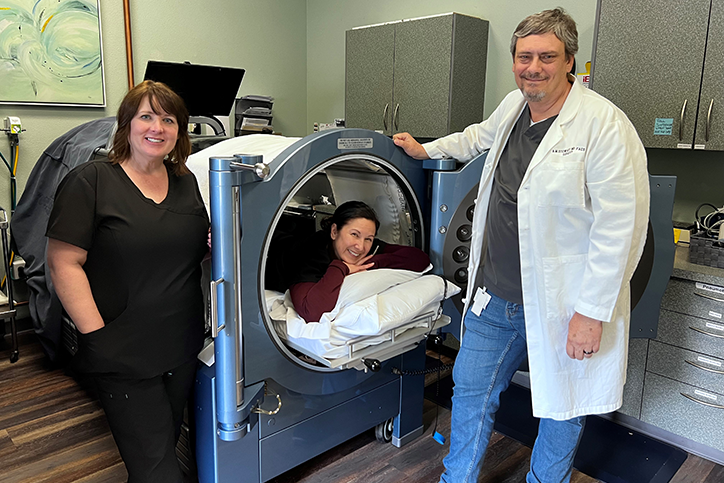Explore the benefits of hyperbaric oxygen therapy for improved healing.
Explore the benefits of hyperbaric oxygen therapy for improved healing.
Blog Article
Discover the Perks of Hyperbaric Oxygen Therapy for Boosted Recovery
Hyperbaric Oxygen Therapy (HBOT) has actually arised as an engaging intervention in the field of recovery, supplying substantial advantages with boosted oxygen distribution to cells. Recognizing the complete extent of HBOT's advantages may lead to transformative results-- yet, a number of crucial considerations stay to be checked out.
What Is Hyperbaric Oxygen Therapy?
Hyperbaric Oxygen Therapy (HBOT) is a clinical therapy that includes the breathing of pure oxygen in a pressurized environment. This therapy operates under the concept that boosting the atmospheric stress permits the body to absorb even more oxygen than it would under typical conditions. Commonly conducted in a hyperbaric chamber, the patient takes a breath 100% oxygen while the chamber stress rises to degrees greater than water level.
HBOT is mainly made use of for conditions such as decompression illness, carbon monoxide gas poisoning, and persistent non-healing wounds, amongst others. The therapy session generally lasts in between 60 to 120 minutes and might vary in regularity depending on the clinical problem being attended to.
During HBOT, oxygen is provided straight to tissues, improving metabolic procedures and advertising the healing feedback. This therapy is typically administered by experienced health care professionals who monitor the individual's vital indications and ensure security throughout the procedure. Although HBOT is an efficient therapy for particular clinical conditions, it is crucial to speak with medical care companies for proper examination and suggestions, as not all conditions are appropriate for this type of therapy.
Exactly How HBOT Improves Healing
The therapeutic impacts of boosted oxygen levels in a pressurized atmosphere play a considerable duty in enhancing the body's all-natural recovery processes. Hyperbaric Oxygen Therapy (HBOT) boosts oxygen saturation in the blood stream, assisting in the transportation of oxygen to tissues that might be robbed of appropriate supply due to injury or ailment - hyperbaric oxygen therapy. This boost in oxygen accessibility promotes mobile regrowth and the formation of brand-new blood vessels, a process known as angiogenesis, which is essential for reliable healing

Additionally, hyperbaric settings counteract unsafe gases, such as carbon monoxide gas, while assisting in the elimination of toxic substances from the body. On the whole, the combination of HBOT into therapy procedures can considerably boost the healing procedure, using an extensive approach to healing and recovery.
Conditions Dealt With With HBOT

Furthermore, HBOT is effective in dealing with persistent non-healing injuries, especially diabetic abscess, by advertising angiogenesis and reducing infection threat. It is additionally made use of for radiation tissue injury, aiding in the recovery of individuals who have undergone radiotherapy for cancer cells.
Various other conditions include carbon monoxide poisoning, where HBOT accelerates the removal of carbon monoxide from the body, and thermal burns, as it offers an oxygen-rich setting for recovery. HBOT has applications in dealing with serious infections such as necrotizing fasciitis, enhancing the effectiveness of antibiotics.

Benefits for Professional Athletes and Energetic People
Just how can professional athletes optimize their healing and efficiency? Hyperbaric Oxygen Treatment (HBOT) supplies an engaging service for athletes and active people looking for to boost their physical capabilities - hyperbaric oxygen therapy. By offering a regulated setting where oxygen is delivered at higher-than-normal atmospheric pressures, HBOT increases the recovery procedure and lowers recuperation times from injuries such as stress, strains, and fractures
Among the key benefits of HBOT lies in its capacity to enhance oxygen supply to cells, advertising mobile repair and regrowth. This is specifically helpful for athletes recovering from extreme training or competitors, as it aids to relieve swelling and muscle mass soreness. Boosted oxygenation can enhance general endurance and endurance, enabling athletes to train harder and much longer.
Furthermore, HBOT has been shown to help in the recovery from blasts and other head injuries, making it a valuable alternative for contact sporting activities professional athletes. By integrating HBOT right into their healing routine, athletes can not just recover much more swiftly but additionally improve their performance levels, setting them on a course to accomplish their individual bests. This therapy stands for an effective tool in the arsenal of contemporary sporting activities medicine.
Security and Factors To Consider of HBOT
Safety is a critical consideration when using Hyperbaric Oxygen Therapy (HBOT) page While this treatment offers numerous advantages, it is necessary to stick to details safety and security methods to alleviate prospective risks. Individuals need to find out go through a detailed clinical evaluation before treatment, ensuring that any kind of contraindications, such as specific lung diseases or a history of ear surgery, are properly analyzed.
Throughout the HBOT session, patients are normally placed in a hyperbaric chamber where air pressure is enhanced. This elevated pressure can posture risks, including oxygen poisoning, which can result in seizures or lung problems if not effectively kept track of. Consequently, it is critical for trained experts to supervise the entire procedure, ensuring that individuals do not go beyond recommended direct exposure times.
Additionally, patients should educate the health care supplier of any type of medications or supplements they are taking, as some might interact detrimentally with HBOT. Post-treatment surveillance is similarly important to recognize any type of postponed adverse effects. By focusing on safety and sticking to established standards, the restorative advantages of HBOT can be optimized while reducing possible hazards, eventually promoting a successful recovery experience.
Conclusion
Finally, Hyperbaric Oxygen Treatment (HBOT) presents a beneficial technique to boosting healing and healing across numerous conditions. By improving oxygen shipment to tissues and advertising mobile regrowth, HBOT properly addresses persistent injuries, decompression health issues, and sports-related injuries. Its benefits for professional athletes, consisting of increased healing times and lowered muscular tissue soreness, underscore its significance in optimizing health and efficiency. Proceeded study and professional application of HBOT will certainly further elucidate its potential benefits in diverse restorative contexts.
Report this page